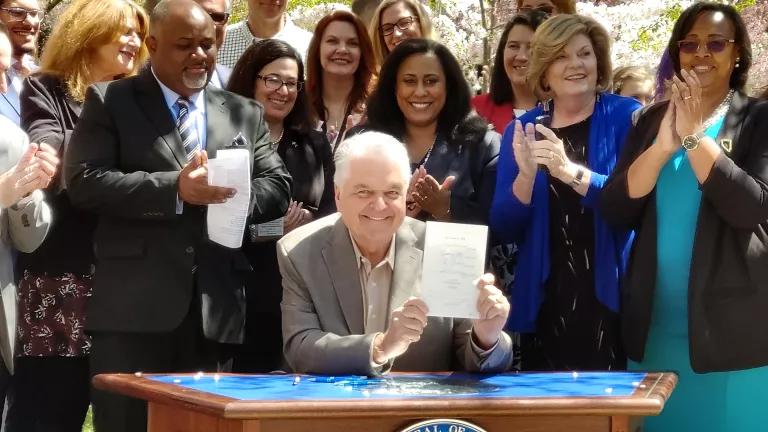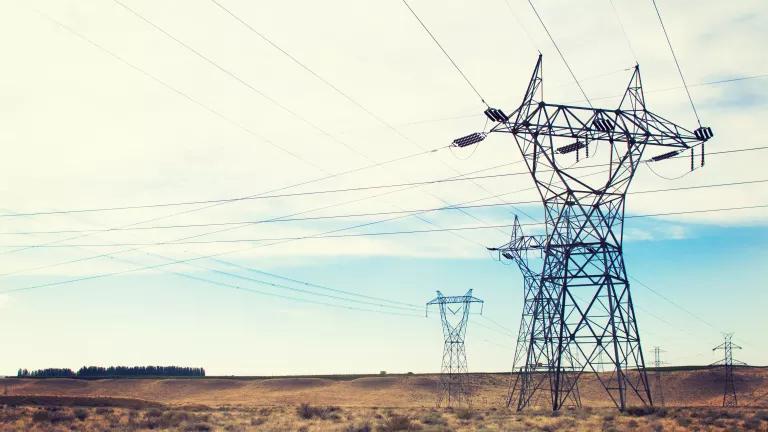NV Ends Legislative Session Full of Action on Clean Energy

Legislators also take first steps on climate
Nevada concluded its 2019 Legislative Session last Monday after passing a series of bills that position the Silver State to lead on renewable energy, climate, efficiency standards, and electric vehicles. Each of these bills takes a necessary step in the movement toward a clean energy, low carbon future that will foster healthy communities, a strong and diversified economy, and preserve wild and working lands in the Silver State for generations to come.
The Nevada Legislature’s impressive performance protecting the climate, economy, and environment is part of a broader shift in Western states, including New Mexico and Colorado. The legislative sessions in all these Western states reflect broad public support for clean energy and climate action and the power of new governors and legislative majorities that prioritize clean energy and climate action, one grounded in regional culture and values.
Unanimous Support for Renewable Energy
On Earth Day, Governor Sisolak fulfilled his promise to Nevadans and signed SB358, a bill sponsored by clean-energy champion Senator Chris Brooks that sets a 50 percent renewable portfolio standard (RPS) for all of the state’s electric utilities. Now, half of Nevada’s electricity will come from clean, renewable energy like solar, wind, and geothermal by 2030 and the state set a goal of 100 percent clean energy by 2050. The bill passed with unanimous, bipartisan support in both chambers, showing legislators understand the broad appeal and popularity of renewable energy across the state. The strong, updated RPS promises to spur economic development across the state, bringing in more than $539 million in wages, generating $1.5 billion in economic activity, and supporting an additional 11,170 green-collar jobs in 2030 in addition to bringing the Silver State cleaner air, healthier habitats and ecosystems, and nearly two million dollars in savings for ratepayers. For more on the clear advantages of clean energy for Nevada, read our blog on SB358, here.
First Steps on Climate
Another one of Senator Brooks’ bills, SB254, was signed by the Governor on June 3. It sets statewide greenhouse gas reduction goals that are in line with the 2015 Paris Agreement, putting into statute the 2025 goal that Governor Sisolak committed the state to when he joined the U.S. Climate Alliance in the spring. Its 2030 and 2050 goals will, if achieved, ensure Nevada is doing its part to avoid dangerous climate change. In addition to setting explicit targets for emissions reductions, SB254 directs state agencies to begin thinking about the policies best suited for Nevada to hit those targets.
Nevada is already on track to meet SB254’s 2025 goal because of earlier bipartisan decisions to close down inefficient, dirty, and expensive coal plants. Since serving more of our energy demands with renewable electricity is the foundation for further emissions reductions in sectors like transportation, the RPS in SB358 will help Nevada meet the 2030 and 2050 targets proposed in this bill. By signing SB254, Governor Sisolak would build on his earlier clean energy leadership and take a vitally important step to safeguard Nevadans’ health, beautiful lands, quality of life, and economy.
Fighting a Trump Rollback
AB54 pushes back against the Trump Administration’s attempt to roll back federal lightbulb efficiency standards. Introduced by the Nevada Governor’s Office of Energy (GOE) and signed by Governor Sisolak in late May, AB54 ensures that Nevadans will maintain access to highly energy efficient lightbulbs, even if Trump’s Department of Energy rolls back some or all of the current standard. Federal lightbulb efficiency standards set an achievable minimum level of efficiency for everyday lightbulbs, which protects consumers. The standards ensure wasteful, energy-guzzling lightbulbs won’t be sold in stores, which also saves consumers money and keeps electricity demand from unnecessarily increasing. These lightbulb efficiency standards were set to go into effect on January 1, 2020 and apply to what regulators call general-service lamps, which are the kind of lightbulbs that can be purchased at hardware stores. (For the exact definition, see here.) Trump’s Department of Energy is proposing to change the definition of general-service lamps to exclude approximately half of the bulbs used in the U.S. AB54 joins Nevada to other states and creates a backstop to this Trump rollback that would waste Nevadan’s money and energy.
Paving the Way for Clean Transportation
The Legislature passed a series of bills (AB377, SB299, and SCR3) that pave the way for the Silver State to begin to reduce carbon and air pollution emissions in the transportation sector. Equally important, State Senate and Assembly representatives held off on implementing unnecessarily high and punitive electric vehicle registration fees that would choke this nascent market in Nevada before it gets a chance to grow.
AB377, sponsored by Assemblyman Howard Watts and signed by Governor Sisolak, makes room for promising clean transportation technology on Nevada’s highways. In line with federal provisions, it provides an exemption on weight limits for heavy-duty electric trucks. This means that Nevada’s weight-limit rules will not effectively punish electric trucks for being electric and running off batteries instead of air-polluting fossil fuels.
SB299 was cosponsored by Senators Brooks and Pat Spearman, overwhelmingly supported in the Legislature, and signed by Governor Sisolak. It creates a small pilot program where funds from an existing clean transportation program can be used to help school districts purchase electric school buses and gain experience using them. This will provide immediate health benefits to the children who rely on public buses to get to school every day, and, as electric bus prices fall and they make up a larger portion of school fleets, this will help everyone who lives or works in the communities through which the current diesel school buses drive.
SCR 3 was a measured and thoughtful response to the thorny issue of how to appropriately fund Nevada’s roads and transportation infrastructure as inflation, increased fuel economy, and eventually, vehicle electrification, reduce fuel tax revenue. Cosponsored by Senators Spearman and David Parks, and shepherded by Assembly Growth and Infrastructure Committee Chair Daniele Monroe-Moreno, SCR3 directs the Legislative Committee on Energy to study how electric vehicles are used in Nevada and what benefits they bring to the state, in addition to how Nevada can appropriately fund roads and other transportation infrastructure as more and more of the vehicles on its highways run off clean electricity. We will be watching this process closely over the next year to make sure electric vehicles are treated fairly—that is to say, that the economic benefits clean cars bring to all ratepayers and the clean air benefits they bring to all drivers are fully recognized. The electric vehicle industry holds great economic potential for Nevada and legislators have to be sure to craft policy that maintains incentives for efficient vehicles. Nevertheless, it is a good sign that Nevada has already started thinking about and studying how to fund its transportation infrastructure down the road, in a more fully decarbonized economy.
Needed Updates to Policy around Large Customer “Exits” from NV Energy
SB547, sponsored by Senator Brooks and awaiting the Governor’s signature, will reform the process that governs how large energy customers, like casinos and mines, “exit” NV Energy’s system and purchase electricity from non-utility businesses. Big customers shouldn’t be able to use their unique ability to purchase electricity on the open market in order to get out of paying for clean energy policies that benefit all Nevadans, like energy efficiency programs. The bill that the Legislature ultimately passed adds much-needed guardrails to the exit process will protect NV Energy ratepayers and, among other things, will ensure future exiting customers will continue to pay for and benefit from energy efficiency programs. From an environmental perspective, this reform could be improved if it applied to the large customers who already made the choice to exit NV Energy, too. Saving energy in buildings reduces costs and emissions, improves air quality and prevents waste. Everyone, especially large energy-consuming customers, needs to do their part.
Conclusion: Nevada’s Future Looks Bright
Thank you, Governor Sisolak and Nevada state representatives! The 2019 Legislative Session demonstrates that the new administration and new and returning legislators are ready to make further strides on climate, clean energy and clean transportation, efficiency, and the environment. The biggest step the Legislature and Governor Sisolak took this session was the unanimous passage of SB358, the 50 percent RPS. There is much work to do before and during the 2021 session, especially in the transportation and buildings sectors. As the Silver State continues to lead on pro-environment policies, we hope to see further action to protect clean air, community health, and wild and working lands in Nevada soon.
This blog was authored by Patricia Valderrama with input from Noah Long.



